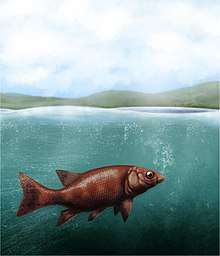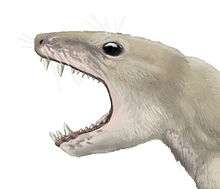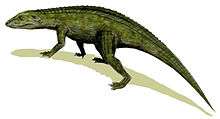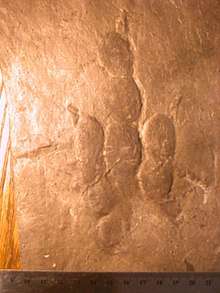McCoy Brook Formation
The McCoy Brook Formation is a geological formation dating to roughly between 200 and 190 million years ago and covering the Hettangian to Sinemurian stages. The McCoy Brook Formation is found in outcrops around the Bay of Fundy, Nova Scotia.
| McCoy Brook Formation Stratigraphic range: Hettangian-Sinemurian | |
|---|---|
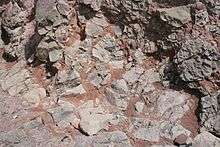 Breccia in the McCoy Brook Formation (Jurassic), Wasson's Bluff, Nova Scotia. | |
| Type | Geological formation |
| Unit of | Newark Supergroup Meriden Group |
| Sub-units | Scots Bay Member |
| Underlies | Erosional top |
| Overlies | North Mountain Basalt |
| Thickness | more than 230 m (750 ft) |
| Location | |
| Coordinates | 45.4°N 64.2°W |
| Approximate paleocoordinates | 27.4°N 13.3°W |
| Region | |
| Country | |
| Extent | Bay of Fundy |
| Type section | |
| Named for | McCoy Brook, Nova Scotia |
 McCoy Brook Formation (Canada) 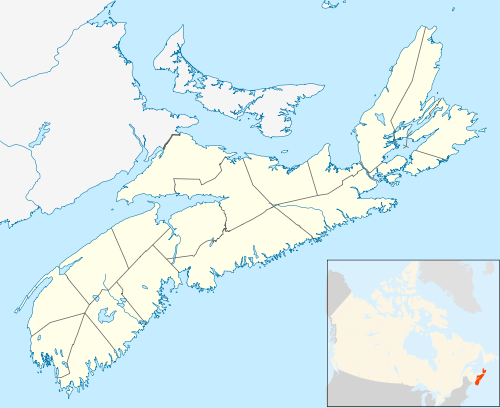 McCoy Brook Formation (Nova Scotia) | |
Agen
The McCoy Brook Formation rests on the North Mountain Basalt, one of the volcanic flows associated with the Triassic–Jurassic boundary in the Newark Supergroup. The base of the McCoy Brook Formation is probably within 100,000 to 200,000 years of the boundary.[1]
Scots Bay Member
This thin unit (9 m) of lacustrine sediments is preserved in six small synclinal outcrops around Scots Bay on the west side of the Blomidon Peninsula. Originally named as the Scots Bay Formation, it is now correlated with the lowermost part of the McCoy Brook Formation, where it is referred to as the Scots Bay Member.[2][3]
Fossil content
Sharks
Color key
|
Notes Uncertain or tentative taxa are in small text; |
| Sharks | ||||||
|---|---|---|---|---|---|---|
| Name | Species | Location | Stratigraphic position | Notes | ||
| cf. Hybodus[1] | None designated[1] | A hybodont shark, found in lacustrine limestone and lacustrine basalt aggregate[1] | 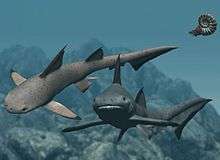 Two Hybodus | |||
Ray-finned fish
| Ray-finned fish | ||||||
|---|---|---|---|---|---|---|
| Name | Species | Location | Stratigraphic position | Material | Notes | Images |
| ?Redfieldiid[1] | None designated[1] | Scales and skull bones[1] | Found in lacustrine limestone and lacustrine basalt aggregate[1] | |||
| aff. Semionotus sp.[1] | None designated[1] | Found in lacustrine limestone, lacustrine basalt aggregate, and lacustrine mudstone[1] | ||||
Synapsids
| Synapsids | ||||||
|---|---|---|---|---|---|---|
| Name | Species | Location | Stratigraphic position | Material | Notes | |
| Pachygenelus[1] | cf. P. monus[1] | A tritheledontid cynodont, found in fluvio-lacustrine sandstone and mudstone, and basalt agglomerate[1] | ||||
| Oligokyphus[4] | sp.[1] | Fragment of a right Dentary. | A tritheledontid cynodont, found in the layers of the Scots Bay member. | |||
| Tritylodontidae | unnamed[1] | Right humerus | A tritylodontid cynodont, found in the layers of the Scots Bay member. | |||
| Cynodontia | unnamed[1] | Partial right unla | A cynodont, found in the layers of the Scots Bay member. | |||
| Cynodontia | unnamed[1] | Proximal portion of a right ischium. | A cynodont, found in the layers of the Scots Bay member. | |||
Sphenodonts
| Sphenodonts | ||||||
|---|---|---|---|---|---|---|
| Name | Species | Location | Stratigraphic position | Material | Notes | |
| C. bairdi[5] | Wasson Bluff[5] | Lower McCoy Brook Formation[5] | Partial skulls and jaws, isolated cranial bones, partial postcranium, postcranial bones[5] | A sphenodontian of relatively small size,[5] found in fluvio-lacustrine sandstone and mudstone, and basalt agglomerate[1] | ||
Crocodyliforms
| Protosuchidae | ||||||
|---|---|---|---|---|---|---|
| Genus | Species | Location | Stratigraphic position | Material | Notes | Images |
| Protosuchus[6] | P. micmac[6] | Wasson Bluff[6] | Lower McCoy Brook Formation[6] | Partial lower jaw, several other skull bones[6] | Found in fluvio-lacustrine sandstone and mudstone, and basalt agglomerate[1] | |
| Sphenosuchid[1] | indeterminate[1] | A maxilla[1] | Found in fluvio-lacustrine sandstone and mudstone, and basalt agglomerate[1] | |||
Dinosaurs
Ornithischia
| Ornithischians | ||||||
|---|---|---|---|---|---|---|
| Genus | Species | Location | Stratigraphic position | Material | Notes | |
| Ornithischia indet. ("Fabrosauridae" indet.)[1] | Indeterminate[1] | Teeth[1] | Found in fluvio-lacustrine sandstone and mudstone, and basalt agglomerate[1] | |||
Sauropodomorpha
| Sauropodomorph dinosaurs | ||||||
|---|---|---|---|---|---|---|
| Genus | Species | Location | Stratigraphic position | Material | Notes | Images |
| Fendusaurus[7] | F. eldoni[7] | Several partial skeletons[1] | Although long assigned to Ammosaurus, the material actually represents a new genus and species;[7] found in fluvio-lacustrine sandstone and mudstone, and basalt agglomerate[1] | |||
Ichnotaxa
Color key
|
Notes Uncertain or tentative taxa are in small text; |
| Ichnotaxa | ||||||
|---|---|---|---|---|---|---|
| Genus | Species | Location | Stratigraphic position | Material | Notes | Images |
| Anomoepus[1] | A. scambus[1] | Footprints | Found in fluvio-lacustrine sandstone and mudstone[1] | |||
| Batrachopus sp.[1] | None designated[1] | Footprints | Found in fluvio-lacustrine sandstone and mudstone[1] | |||
| Grallator sp.[1] | None designated[1] | Footprints | Found in fluvio-lacustrine sandstone and mudstone[1] | |||
| Otozoum[1] | O. moodi[1] | Footprints | Found in fluvio-lacustrine sandstone and mudstone[1] | |||
See also
- List of dinosaur-bearing rock formations
References
- Shubin, N. H.; Olsen, P. E.; Sues, H.-D. (1994). "Early Jurassic small tetrapods from the McCoy Brook Formation of Nova Scotia, Canada". In Fraser, N. C.; Sues H. D. (eds.). In the Shadow of the Dinosaurs. Cambridge, United Kingdom: Cambridge University Press. pp. 242–250. ISBN 0-521-45899-4.
- Tanner, L.H. (1996). "Formal definition of the Lower Jurassic McCoy Brook Formation, Fundy Rift Basin, eastern Canada". Atlantic Geology. 32: 127–135. Retrieved 15 December 2012.
- Hassan, H.S. "Sedimentology and Paleontology of the Lower Jurassic Scots Bay Formation, Bay of Fundy, Nova Scotia, Canada" (PDF). MSc thesis. Retrieved 24 November 2012.
- Tim Fedak, Hans-Dieter Sues, Paul E. Olsen: "First record of the tritylodontid cynodont Oligokyphus and cynodont postcranial bones from the McCoy Brook Formation of Nova Scotia, Canada".Canadian Journal of Earth Sciences 52(4):150313143816000 · March 2015
- Sues, H.-D.; Shubin, N. H.; Olsen, P. E. (1994). "A new sphenodontian (Lepidosauria: Rhynchocephalia) from the McCoy Brook Formation (Lower Jurassic) of Nova Scotia, Canada". Journal of Vertebrate Paleontology. 14 (3): 327–340. doi:10.1080/02724634.1994.10011563.
- Sues, H.-D.; Shubin, N. H.; Olsen, P. E.; Amaral, W. W. (1996). "On the cranial structure of a new protosuchid (Archosauria: Crocodyliformes) from the McCoy Brook Formation (Lower Jurassic) of Nova Scotia, Canada". Journal of Vertebrate Paleontology. 16 (1): 34–41. doi:10.1080/02724634.1996.10011281.
- Fedak, T. J. (2007). Description and evolutionary significance of the sauropodomorph dinosaurs from the early Jurassic (Hettangian) McCoy Brook Formation. Ph.D. dissertation. Halifax, Nova Scotia: Dalhousie University.
